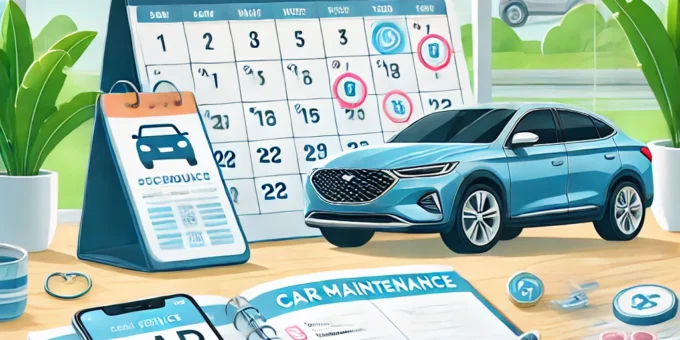
Keeping your car in peak condition requires more than just driving carefully—it demands consistent and timely maintenance. Scheduling regular car services is the foundation of a well-maintained vehicle, extending its life, boosting performance, and ensuring safety.
This complete guide will walk you through everything you need to know about scheduling regular car services, from understanding maintenance intervals to leveraging tools that simplify the process. By the end, you’ll have a clear roadmap for keeping your car in optimal shape.
Why Routine Car Maintenance is Critical
Regular car servicing is essential for the following reasons:
- Improved Safety: Ensures critical systems like brakes, tires, and lights are functioning properly.
- Increased Longevity: Prevents premature wear and tear, keeping your car on the road longer.
- Better Performance: Maintains optimal fuel efficiency, smooth handling, and engine performance.
- Cost Savings: Fixing minor issues early avoids costly repairs in the future.
- Higher Resale Value: A well-maintained car attracts better offers from buyers.
What is Regular Car Service?
A regular car service typically includes a combination of inspections, adjustments, and replacements to keep your vehicle running smoothly. Common tasks include:
- Oil and filter changes.
- Tire rotation and alignment checks.
- Fluid top-offs (coolant, brake fluid, transmission fluid).
- Brake pad and rotor inspections.
- Battery checks.
- Air filter and cabin filter replacements.
Understanding Maintenance Intervals
Car maintenance is generally scheduled based on:
- Mileage Intervals: Commonly at 5,000, 10,000, 15,000 miles, and beyond.
- Time Intervals: For cars driven infrequently, services are recommended every 6–12 months.
Example of Typical Maintenance Schedule:
- 5,000 Miles: Oil change, tire rotation, fluid level check.
- 15,000 Miles: Replace air filter, inspect brakes, check suspension.
- 50,000 Miles: Replace spark plugs, inspect timing belt, flush coolant.
Tip: Refer to your owner’s manual for the exact schedule tailored to your car.
Step 1: Read Your Owner’s Manual
The owner’s manual is your best resource for understanding your car’s maintenance needs.
- Look for the “Maintenance Schedule” section.
- Note the mileage and time intervals for specific tasks like oil changes and brake checks.
Tip: Keep the manual in your glove box for easy reference.
Step 2: Learn the Basics of Car Maintenance Tasks
Understanding what’s included in regular maintenance helps you stay informed and avoid unnecessary expenses.
- Oil and Filter Changes: Essential for engine lubrication and cooling.
- Tire Maintenance: Rotation, alignment, and pressure checks ensure even wear and fuel efficiency.
- Brake Inspections: Monitor pad thickness and rotor condition for safe braking.
- Fluid Checks: Keep coolant, transmission fluid, and brake fluid at optimal levels.
Step 3: Identify Your Car’s Service Milestones
Every car has specific maintenance milestones.
Examples:
- 5,000 Miles: Basic checks and oil changes.
- 30,000 Miles: Replace air filters and inspect hoses.
- 100,000 Miles: Timing belt replacement and comprehensive inspections.
Tip: Use a tracking app to remind you of upcoming services.
Step 4: Create a Car Service Calendar
A car service calendar helps you stay on top of regular maintenance.
How to Set Up a Calendar:
- Use apps like Google Calendar or Carfax Car Care.
- Set reminders for oil changes, tire rotations, and inspections.
- Include seasonal tasks like checking wiper blades before winter.
Step 5: Use Online Service Schedulers
Many dealerships and repair shops offer online scheduling tools for easy booking.
Popular Platforms:
- Your Manufacturer’s Website: Schedule services at authorized dealerships.
- RepairPal: Compare repair shops and book appointments.
- Jiffy Lube Online: Convenient for oil changes and quick services.
Step 6: Choose the Right Service Center
Not all service centers are created equal. Choose one that offers:
- Certified Technicians: Look for ASE certification or manufacturer-trained mechanics.
- Transparent Pricing: Clear estimates for services and repairs.
- Good Reviews: Check online ratings and customer feedback.
Tip: Build a relationship with a trusted mechanic for personalized service.
Step 7: Keep Track of Service Records
Maintain a log of all services performed, including dates and mileage.
Why It’s Important:
- Helps you stick to your schedule.
- Increases your car’s resale value by showing a history of regular maintenance.
Tools for Tracking Records:
- Use a physical logbook or apps like Carfax Car Care or AUTOsist.
How to Budget for Regular Maintenance
Typical costs for regular car servicing:
- Oil Change: $35–$75.
- Tire Rotation: $20–$50.
- Brake Pad Replacement: $150–$300.
- Coolant Flush: $100–$150.
Tip: Set aside a small monthly budget for routine maintenance to avoid unexpected expenses.
Seasonal Car Maintenance Tips
- Winter: Check antifreeze levels, inspect the battery, and switch to winter tires.
- Summer: Test the air conditioning, inspect the cooling system, and replace wipers if needed.
DIY vs. Professional Servicing
Some tasks, like checking tire pressure or replacing wiper blades, can be done at home. However, complex jobs like brake repairs or timing belt replacements should be handled by professionals.
DIY Tasks:
- Replacing air filters.
- Checking oil and coolant levels.
Professional Tasks:
- Transmission flushes.
- Engine diagnostics.